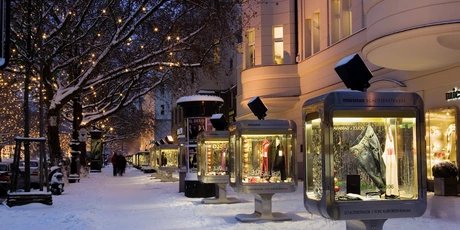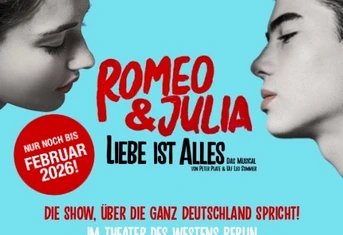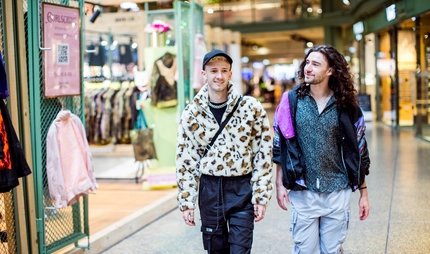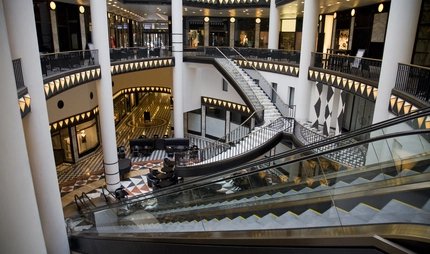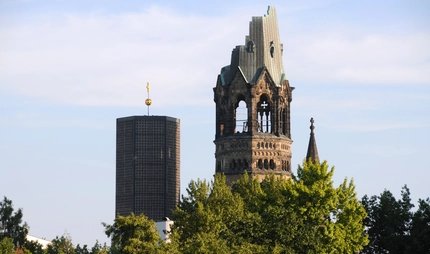
Shopping around the Kurfürstendamm in Berlin
Luxury labels, culture and world-famous sights
The elegant Kurfürstendamm in Berlin is a legend and world-famous! Today it is the undisputed centrepiece of City West. Take your time for an enjoyable stroll down it - you won't be able to stop looking. Take a detour into the side streets, refresh yourself in one of the stylish little restaurants and discover upmarket shops and boutiques.
Everything about the Kurfürstendamm in sign language and easy-to-read.
Around 450 years ago, the Elector of Berlin rode along Kurfürstendamm to hunt in the Grunewald forest. Today, Berliners and visitors to Berlin stroll down the Ku'damm - as it is popularly known - to shop, be inspired by trendy fashion brands and elegant luxury labels and take a detour to the capital's upmarket interior design shops.
Kurfürstendamm shopping experience: a carefree stroll and elegant shopping
Start your stroll along Kurfürstendamm in a westerly direction at Berlin's Breitscheidplatz. From here, the approximately 3.5 kilometre-long boulevard leads to Rathenauplatz, where the villa district in Grunewald begins. But don't worry - your walk doesn't have to be that long. You will find the most splendid shops between Uhlandstraße and Olivaer Platz.
Tip: You will find our shop recommendations listed below. Have fun!
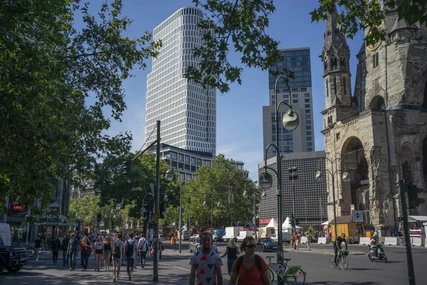
The Kurfürstendamm officially begins at Breitscheidplatz , before that the street was called Tauentzienstraße. Incidentally, this leads eastwards to Wittenbergplatz, where the legendary KaDeWe department stores ' is located - probably the most famous department stores' in the capital. Still on the Tauentzienstraße side, the Europa-Center with the Mercedes star visible from afar is one of the oldest shopping centres in Berlin.
Now walk down Kurfürstendamm in a westerly direction. Between Breitscheidplatz and Uhlandstraße you will find a wide range of shopping opportunities. Whether flagship stores and shops of well-known, upmarket brands such as Apple, Boss, Armani, Lacoste, Roeckl, Falke, Liebeskind, Marc O'Polo or trendy fashion chains such as H&M - here you will find everything you need to shop well and in between larger tourist restaurants, cafés and steakhouses.
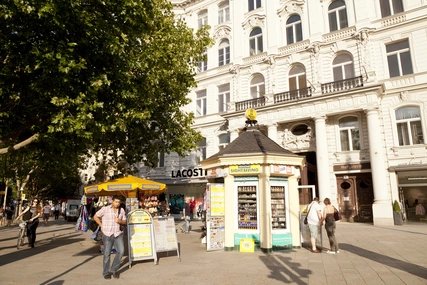
International and renowned interior and porcelain shops such as Königliche Porzellan-Manufaktur KPM, Villeroy & Boch, Occhio, the exclusive design house for light, and Zara Home are locatedaround the Uhlandstraße intersection. A few steps up Uhlandstraße and you will find elegant interiors and designer furniture from top brands on Kantstraße, in Living Berlin.
Elegance
Towards Olivaer Platz, pure high fashion: immerse yourself in the top elegant mile of Kurfürstendamm with every step you take. The magnificent wide pavements are quieter and the tall historic building façades conceal sophisticated shop windows behind which designers and world-famous luxury labels seduce their discerning clientele with clothes, shoes, jewellery and accessories.
Here is a current selection:

- Karl Lagerfeld
- Longchamp
- Cartier
- Aigner
- Gucci
- Dior
- Chanel
- Tiffany
- Salvatore Ferragamo
- Balenciaga
- Brunello Cucinelli
- Chopard
- Rolex
- Zegna
- Louis Vitton
- Valentino
- Hermès
- Dolce&Gabbana
- Bottega Veneta
- Etro
Not to be missed: the side streets of the Kurfürstendamm

Don't forget to take a detour to the side streets of Kurfürstendamm and feel a touch of Parisian charm: go on a discovery tour to Bleibtreustraße and Knesebeckstraße. The beautiful historic house facades with their magnificent entrances are a feast for the eyes in themselves.
They harbour small, fine boutiques like Janet Knaack.The Berlin boutique sells its own collection and produces the timeless designs directly in the city. We stay fashionable and close to home. At L'Ephemere you will find casual clothing with enormous class. Shoes and accessories round off the outfits.
Shoe shops, jewellers and exquisite interior design shops.
In between, you will find sushi bars, Indian curry, German or Austrian cuisine for lunch in between or an elegant dinner. In Knesebeckstraße, French specialities, Mexican street food and, afterwards, coffee roasted in-house with milk foam acrobatics in the Coffee Bar.
Turn left from Bleibtreustraße into Mommsenstraße and head for Jochum Rodgers. The gallery presents furniture and furnishings in classic designs "from the middle of the century".
Just one house further on is a designer second-hand shop. Take enough time to visit the boutique, because it's worth browsing: from Valentino to Chanel and Louis Vuitton, you can find real luxury brands at reasonable prices at Macyʼz.
You can find exciting reads in the cosy and traditional Marga Schöller Bücherstube. On the way to the beautifully designed Savignyplatz , not far away, with its numerous cafés and restaurants, you will pass a kitchen shop with sophisticated, functional and chic cookery utensils. Last but not least, the Bücherbogen bookshop, which focuses on art, film and culture, should be mentioned here - once the declared bookshop favourite of designer Karl Lagerfeld.
Around Savignyplatz and Bleibtreustraße: restaurants and cafés
City West: classy and chic. But not only that. Of course, the region likes to play up this side. But it can also be different. The 1900 Bistro Café is very cosy, Nah am Wasser is modern and cool, and What do you fancy love? is hip and casual.
At Petrocelliʼs Bar on Savignyplatz, you can relax under chandeliers in a stylish ambience. Donʼt let the "bar" in the name put you off - you can also order delicious Italian food to go with your coffee or drink. Prefer something on the go? Koshary Lux serves delicious street food from Egypt and the Middle East

You will also find good restaurants on Bleibtreustraße. Kushinoya serves a Japanese speciality. Try the traditional kushiage bamboo skewers with deep-fried vegetables, meat and fish. Fine sushi dishes and other Japanese specialities are also on the menu at The Catch. Lubitsch, just off Niebuhrstraße, offers fine-dining cuisine in the "Berlin, Vienna, Paris" triangle. La Cantina at Bleibtreustraße 17 also presents Berlin at its culinary best.
Culture and sights on Kurfürstendamm
Kurfürstendamm not only offers you an exquisite shopping world and numerous culinary delights, but also cultural experiences and famous sights.
At the beginning of the boulevard on Breitscheidplatz is the impressive Kaiser Wilhelm Memorial Church with its special architectural history. On hot or rainy days, you can take a break here and find some peace and quiet. Right next door, in the Europa Centre, Berlin's oldest cabaret, Die Stachelschweine, invites you to a light-hearted evening with plenty of subtle humour. Behind the Gedächtniskirche is the Bikini Berlin, the legendary Zoo Palast cinema and the luxury Waldorf Astoria hotel, an elegant new district. Just behind it, the whole family can relax in the Tiergarten, Berlin's green lung, with the Zoo Berlin.

An interesting example of contemporary architecture is the curved Ku'damm-Eck on the corner of Joachimsthaler Straße. In the Kranzler Eck opposite, the chairs of the historic Café Kranzler stood on the pavement until it was rebuilt in 2000. Today, the red and white striped awning still adorns the rotunda of Neues Kranzler Eck.
The cabaret theatre Die Stachelschweine is by no means the only stage on Kurfürstendamm. Around two and a half kilometres away on Adenauerplatz, Kurfürstendamm is home to one of Berlin's most important, internationally renowned theatres, the Schaubühne. With its gripping productions and top actors, it continues to write theatre history.
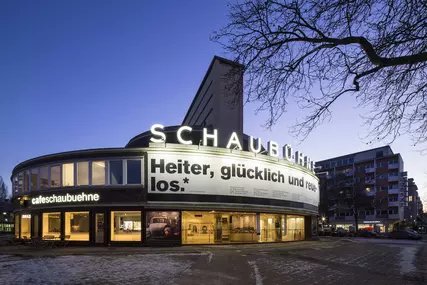
A short distance from Kurfürstendamm you will find the Stage Theatre des Westens. You can experience exciting musical highlights on this large stage in a magnificent Wilhelmine building on Kantstraße, which has been in existence for more than a hundred years.
Shopping around the Kurfürstendamm:
Luxury department stores
Luxury labels
Book & Gifts
Before you start...
...make yourself comfortable, grab your in-ears and join us on an audio adventure tour down Kurfürstdamm! With our podcast Berlin Unboxed: In the episode Mythos Ku'damm we reveal many a secret of the Kurfürstendamm in a concise and impressive way.
To the visitBerlin Podcast Berlin Unboxed
At a glance
In which Berlin district is Kurfürstendamm located?
Kurfürstendamm is located in the Charlottenburg-Wilmersdorf district.
How long is Kurfürstendamm?
It is 3.5 kilometres long.
Is Kurfürstendamm located in the western or eastern part of the city?
It is in the western part of Berlin.
What series is there about Kurfürstendamm?
The series KU'DAMM 63 is about a family story in Berlin in the 1950s and 1960s.
Which famous sights are located on Kurfürstendamm?
In the immediate vicinity of Kurfürstendamm at the western end of the boulevard are the KaDeWe department stores', the Kaiser Wilhelm Memorial Church and Breitscheidplatz with the Europacenter. Close to Kurfürstendamm you will also find Zoo Berlin and the Theatre of the West. About two and a half kilometres to the west is the Schaubühne Berlin directly on Kurfürstendamm.
And last but not least: a look back at the history of Kurfürstendamm
Around 1542,Elector Joachim II of Brandenburg had an embankment path built behind the Brandenburg Gate as a bridle path from the Berlin City Palace to the Grunewald Hunting Lodge . The oldest evidence of the existence of the unnamed bridleway is the 1685 "Plan géométral de Berlin et des environs" by the engineer La Vigne. It was not until 1886 that the road was completed and the development of the boulevard could begin.
The birthday of the boulevard is 5 May 1886 - the day on which the Zoologischer Garten - Halensee steam tram line commenced service.
In the 1920s, Kurfürstendamm was the centre of the New West, where poets, journalists and intellectuals met in the Romanisches Café (now the Europa-Center) and the Café des Westens (later Café Kranzler).
At the time of the Wall, Kurfürstendamm was the heart of old West Berlin, the shop window of the West, with the latest fashions on display in its showcases. Hildegard Knef sang about the Kurfürstendamm as a place of longing in her Berlin song: "I'm so homesick for the Kurfürstendamm". At these times, Berliners and guests stroll along the boulevard, sit in the famous Kranzler and Möhring street cafés, stroll through shops and department stores and dance the night away in the discos.
After reunification, the evenings became quieter on Kurfürstendamm and in City West as nightlife shifted to the districts in the east, where the new clubs opened. Many of the long-established cafés and restaurants closed. Of the more than 20 cinemas that once existed, two still remain today: the Cinema Paris in the Centre Français and the Astor Filmlounge.
However, Kurfürstendamm has also benefited from the upswing in City West in recent years with the new Zoo Palast and the Bikini , and has once again developed into an elegant shopping street.
Guided tours through the City West

Tickets for guided tours and tours
Let yourself be guided through City West in a small group: On the tour, you will learn exciting stories about the Kudamm and discover hidden places at the Kaiser Wilhelm Memorial Church.
Tickets for individual city tours
A little tip:
Pay attention to the house numbers on Kurfürstendamm. You will search in vain for numbers 1 to 10, they no longer exist. They have been part of Budapester Strasse since the 1920s.
